CADILLAC ELDORADO 1995 10.G Owners Manual
Manufacturer: CADILLAC, Model Year: 1995, Model line: ELDORADO, Model: CADILLAC ELDORADO 1995 10.GPages: 395, PDF Size: 20.17 MB
Page 211 of 395
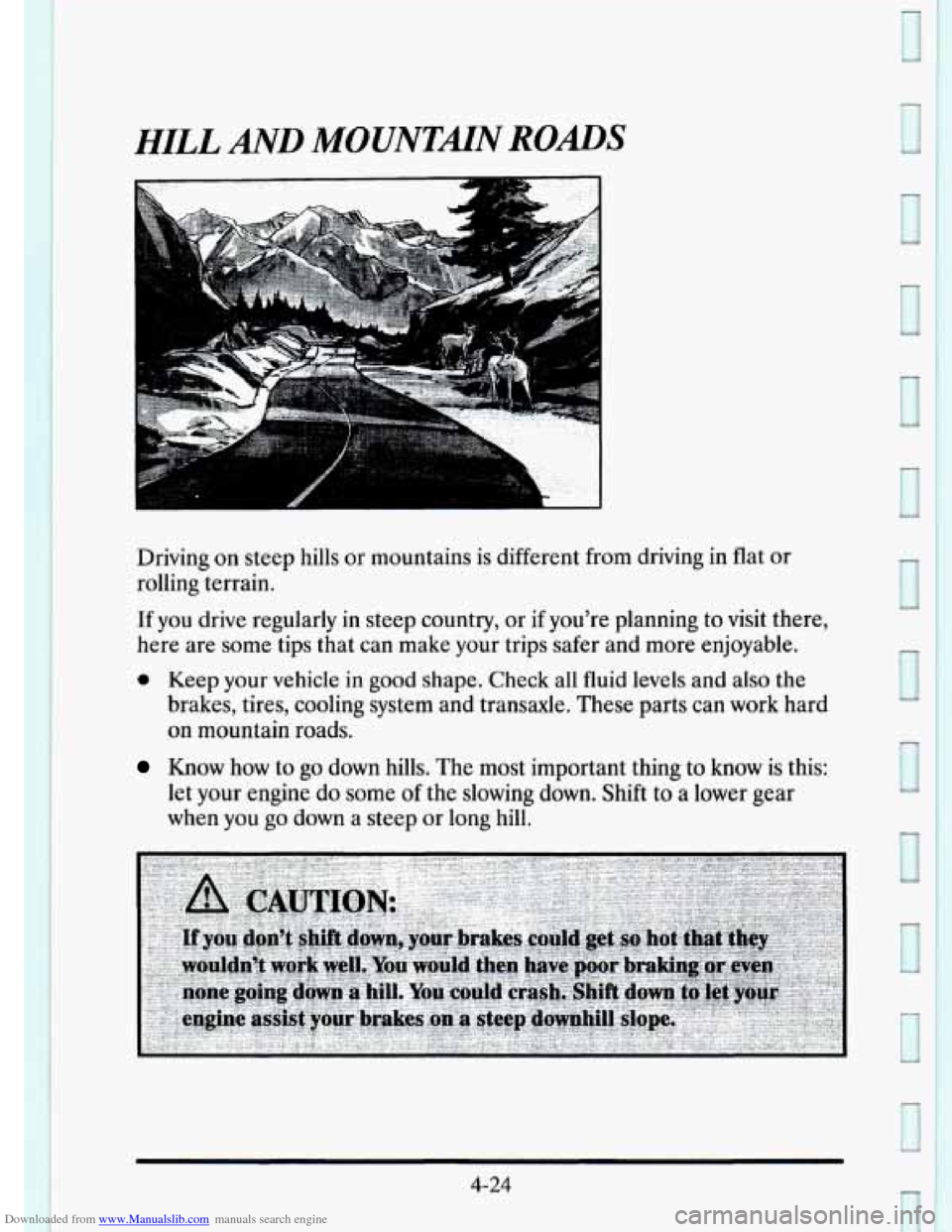
Downloaded from www.Manualslib.com manuals search engine HILL AND MOUNTMN ROADS
Driving on steep hills or mountains is different from driving in flat or
rolling terrain.
If you drive regularly in steep country, or if you’re planning to visit there,
here are some tips that can make your trips safer and more enjoyable.
0 Keep your vehicle in good shape. Check all fluid levels and also the
brakes, tires, cooling system and transaxle. These parts can work hard
on mountain roads.
Know how to go down hills. The most important thing to know is this:
let your engine do some
of the slowing down. Shift to a lower gear
when you
go down a steep or long hill.
4-24
Page 212 of 395
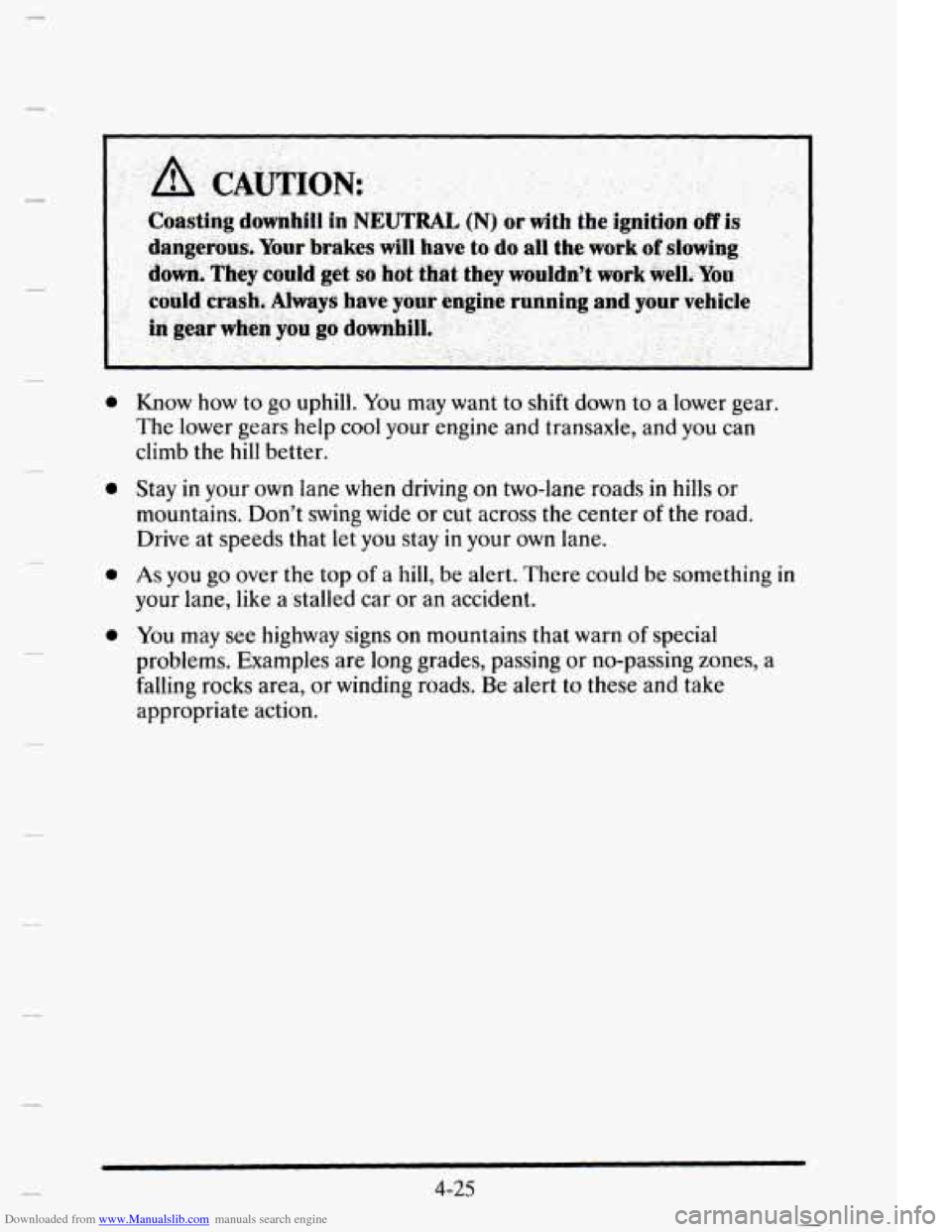
Downloaded from www.Manualslib.com manuals search engine I I
a
e
0
e
Know how to go uphill. You may want to shift down to a lower gear.
The lower gears help cool your engine and transaxle, and you can
climb the hill better.
Stay in your
own lane when driving on two-lane roads in hills or
mountains. Don’t swing wide or cut across the center
of the road.
Drive at speeds that let
you stay in your own lane.
As you go over the top of a hill, be alert. There could be something in
your lane, like a stalled car or an accident.
You may see highway signs
on mountains that warn of special
problems. Examples are long grades, passing or no-passing zones, a
falling rocks area, or winding roads.
Be alert to these and take
appropriate action.
4-25
Page 213 of 395
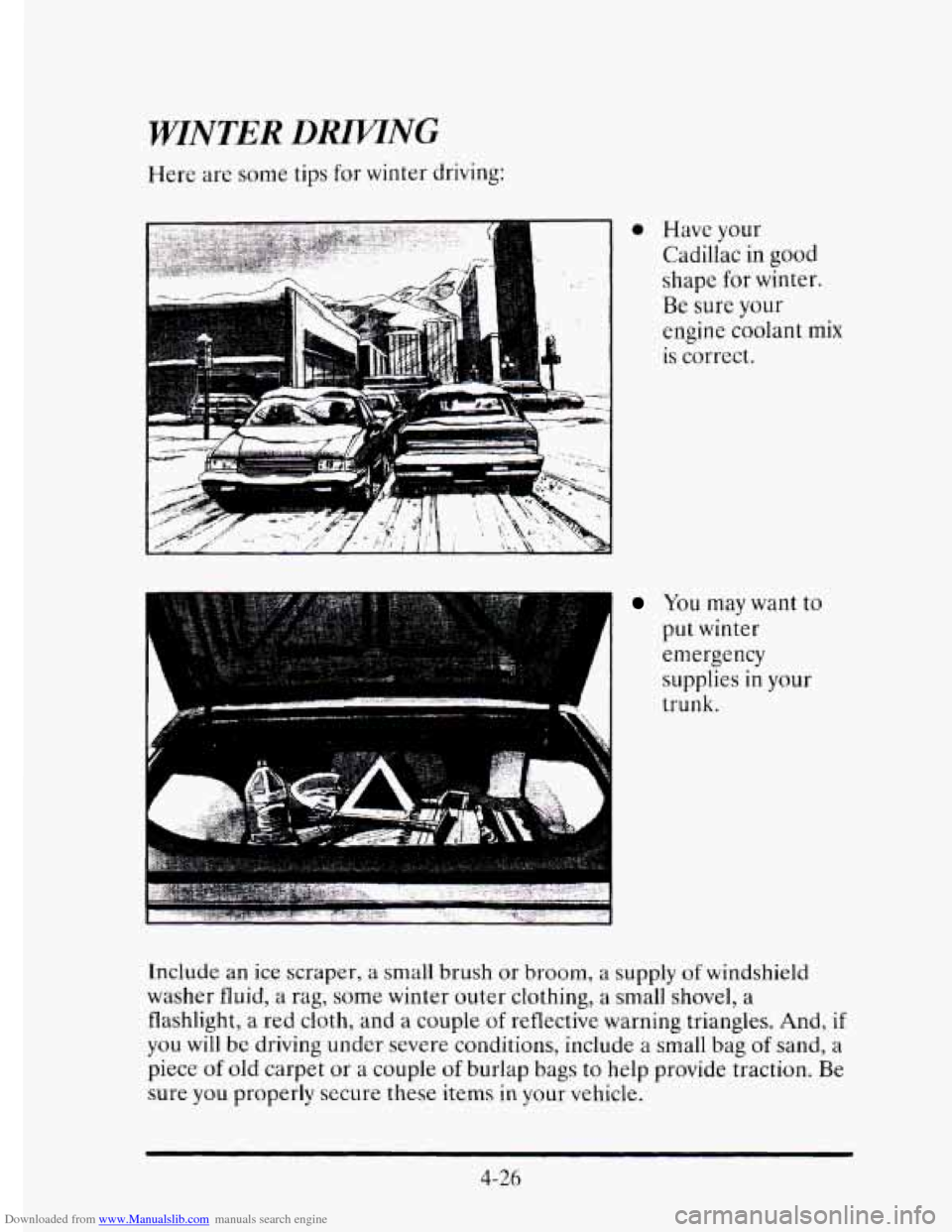
Downloaded from www.Manualslib.com manuals search engine WINTER DRIVTNG
Here are some tips for winter driving:
0 Have your
Cadillac in
good
shape for winter.
Be sure your
engine coolant mix
is correct.
You may want to
put winter
emergency
supplies in your
trunk.
Include an ice scraper,
a small brush or broom, a supply of windshield
washer fluid, a rag, some winter outer clothing, a small shovel,
a
flashlight, a red cloth, and a couple of reflective warning triangles. And, if
you will be driving under severe conditions, include a small bag of sand, a
piece of old carpet or a couple of burlap bags to help provide traction. Be
sure you properly secure these items in your vehicle.
4-26
Page 214 of 395
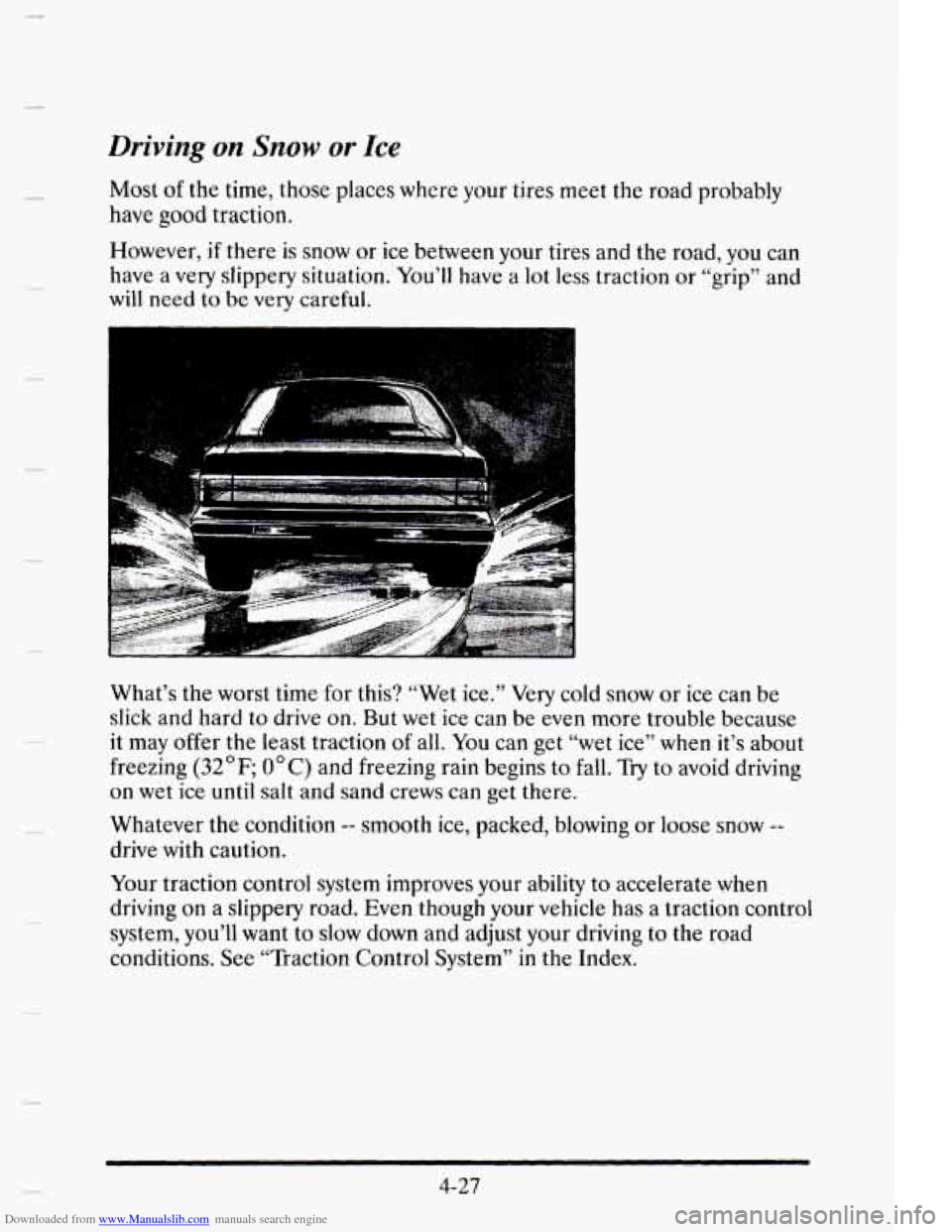
Downloaded from www.Manualslib.com manuals search engine Driving on Snow or Ice
Most of the time, those places where your tires meet the road probably
have good traction.
However,
if there is snow or ice between your tires and the road, you can
have a
very slippery situation. You’ll have a lot less traction or “grip” and
will need to be very careful.
. . ..
What’s the worst time for this? “Wet ice.” Very cold sn ow or ice can be
slick and hard
to drive on. But wet ice can be even more trouble because
it may offer the least traction of all. You can get “wet ice” when it’s about
freezing
(32°F; 0°C) and freezing rain begins to fall. Try to avoid driving
on
wet ice until salt and sand crews can get there.
Whatever
the condition -- smooth ice, packed, blowing or loose snow --
drive with caution.
Your traction control system improves your ability
to accelerate when
driving on
a slippery road. Even though your vehicle has a traction control
system, you’ll want
to slow down and adjust your driving to the road
conditions. See “Traction Control System”
in the Index.
4-27
Page 215 of 395
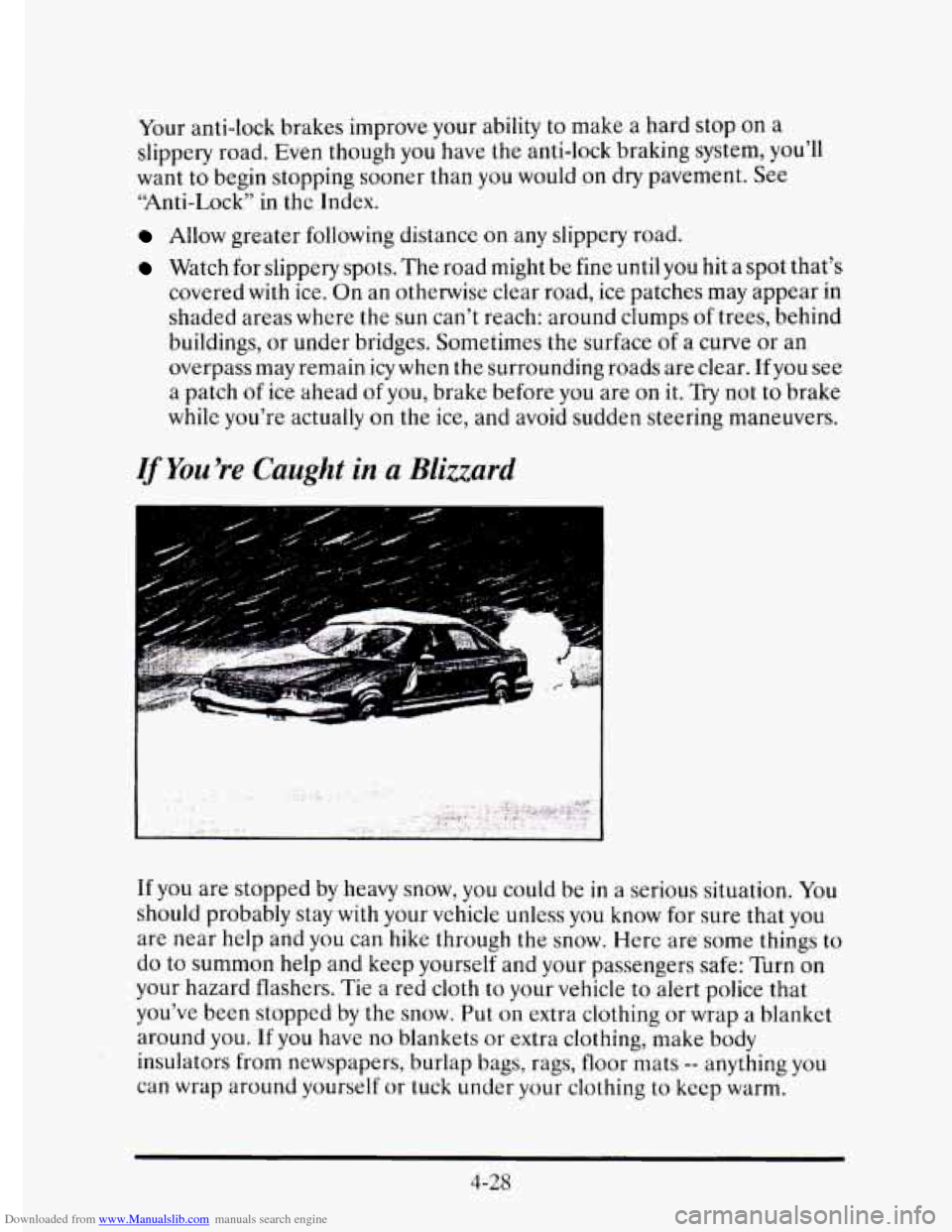
Downloaded from www.Manualslib.com manuals search engine Your anti-lock brakes improve your ability to make a hard stop on a
slippery road. Even though you have the anti-lock braking system, you’ll
want
to begin stopping sooner than you would on dry pavement. See
“Anti-Lock” in the Index.
Allow greater following distance on any slippery road.
Watch for slippery spots. The road might be fine until you hit a spot that’s
covered with ice. On an otherwise clear road, ice patches may appear in
shaded areas where
the sun can’t reach: around clumps of trees, behind
buildings, or under bridges. Sometimes the surface
of a curve or an
overpass may remain icy when
the surrounding roads are clear. If you see
a patch of ice ahead
of you, brake before you are on it. Try not to brake
while you’re actually on the ice, and avoid sudden steering maneuvers.
You’re Caught in a Blizzard
If you are stopped by heavy snow, you could be in a serious situation. You
should probably stay with your vehicle unless you know for sure that you
are near help and you can hike through
the snow. Here are some things to
do to summon help and keep yourself and your passengers safe: Turn on
your hazard flashers. Tie
a red cloth to your vehicle to alert police that
you’ve been stopped by the snow. Put on extra clothing
or wrap a blanket
around you.
If you have no blankets or extra clothing, make body
insulators from newspapers, burlap bags, rags, floor mats
-- anything you
can wrap around yourself or tuck under your clothing to keep warm.
4-28
Page 216 of 395
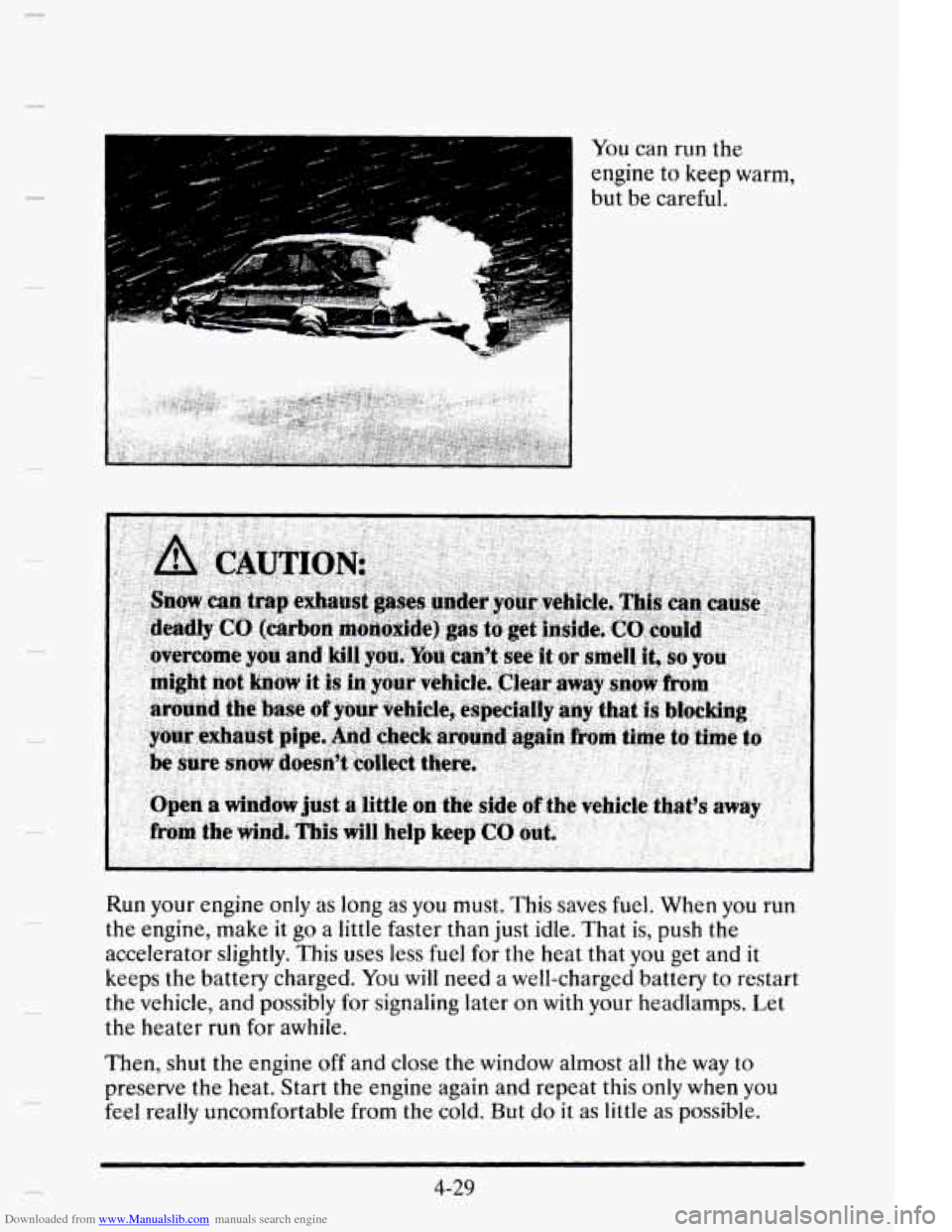
Downloaded from www.Manualslib.com manuals search engine I
You can run the
engine to keep warm,
but be careful.
Run your engine only as long as
you must. This saves fuel. When you run
the engine, make it go a little faster than just idle. That is, push the
accelerator slightly. This uses less fuel for the heat that you get and it
keeps the battery charged. You
will need a well-charged battery to restart
the vehicle, and possibly
for signaling later on with your headlamps. Let
the heater run
for awhile.
Then, shut the engine off and close the window almost all the way to
preserve the heat. Start the engine again and repeat this only when you
feel really uncomfortable from the cold. But
do it as little as possible.
4-29
Page 217 of 395
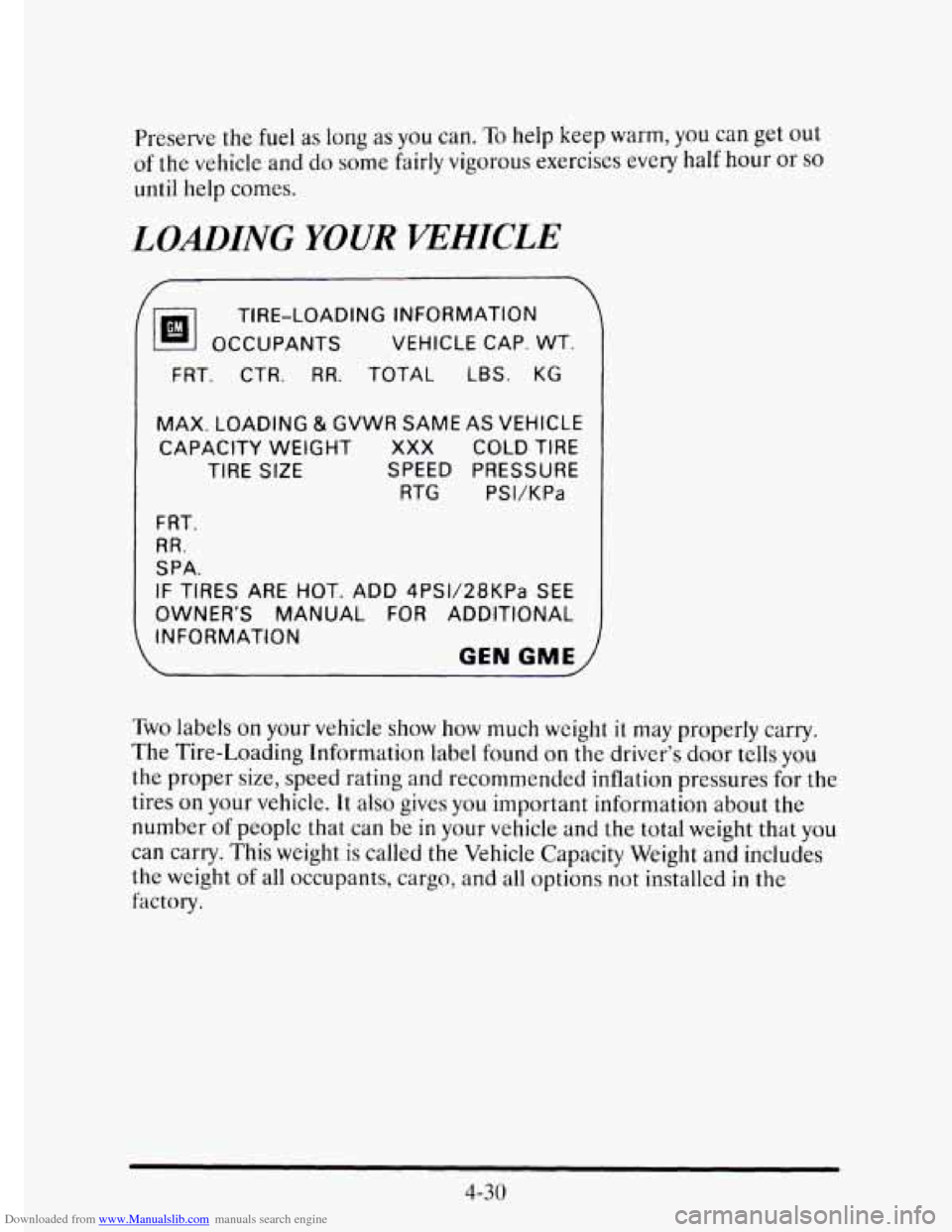
Downloaded from www.Manualslib.com manuals search engine Preserve the fuel as long as you can. To help keep warm, you can get out
of the vehicle and do some fairly vigorous exercises every half hour or
SO
until help comes.
LOmING YOUR VEHICLE
~~
( TIRE-LOADING INFORMATION
OCCUPANTS VEHICLE CAP.
WT.
FRT. CTR. RR. TOTAL LBS. KG
MAX. LOADING
& GVWR SAME AS VEHICLE
CAPACITY WEIGHT XXX
COLD TIRE
TIRE SIZE SPEED PRESSURE
RTG PSVKPa
F
RT.
RR.
SPA.
IF TIRES ARE HOT. ADD 4PSV28KPa SEE
OWNER’S MANUAL FOR ADDITIONAL
INFORMATION
-_ - - - GEN GME,
Two labels on your vehicle show how much weight it may properly carry.
The Tire-Loading Information label found
on the driver’s door tells you
the proper size, speed rating and recommended inflation pressures for the
tires
on your vehicle. It also gives you important information about the
number
of peoplc that can be in your vehicle and the total weight that you
can carry. This weight
is called the Vehicle Capacity Weight and includes
the weight
of all occupants, cargo, and all options not installed in the
factory.
4-30
Page 218 of 395

Downloaded from www.Manualslib.com manuals search engine MfD BY GENERAL MOTORS CORP
DATE GVWR GAWR FRT GAWR RR
THIS VEHICLE CONFORMS TO ALL APPLI-
CABLE U.S. FEDERAL
MOTOR VEHICLE
TION STANDARDS
IN EFFECT ON THE
DATE OF MANUFACTURE SHOWN ABOVE.
SAFETY, BUMPER, AND THEFT
PREVEN-
GEN GME 1
The other label is the Certification label, found on the rear edge of the
driver’s door. It tells you
the gross weight capacity of your vehicle, called
the GVWR (Gross Vehicle Weight Rating). The GVWR includes the
weight
of the vehicle, all occupants, fuel and cargo. Never exceed the
GVWR for your vehicle, or the Gross
Axle Weight Rating (GAWR) for
either the front or rear axle.
If you do have a heavy load, you should spread
it out. Don’t carry more
than
176 pounds (80 kg) in your trunk.
If you put things inside your vehicle
-- like suitcases, tools, packages, or
anything else
-- they will go as fast as the vehicle goes. If you have to stop
or turn quickly, or
if there is a crash, they’ll keep going.
4-3 1
Page 219 of 395
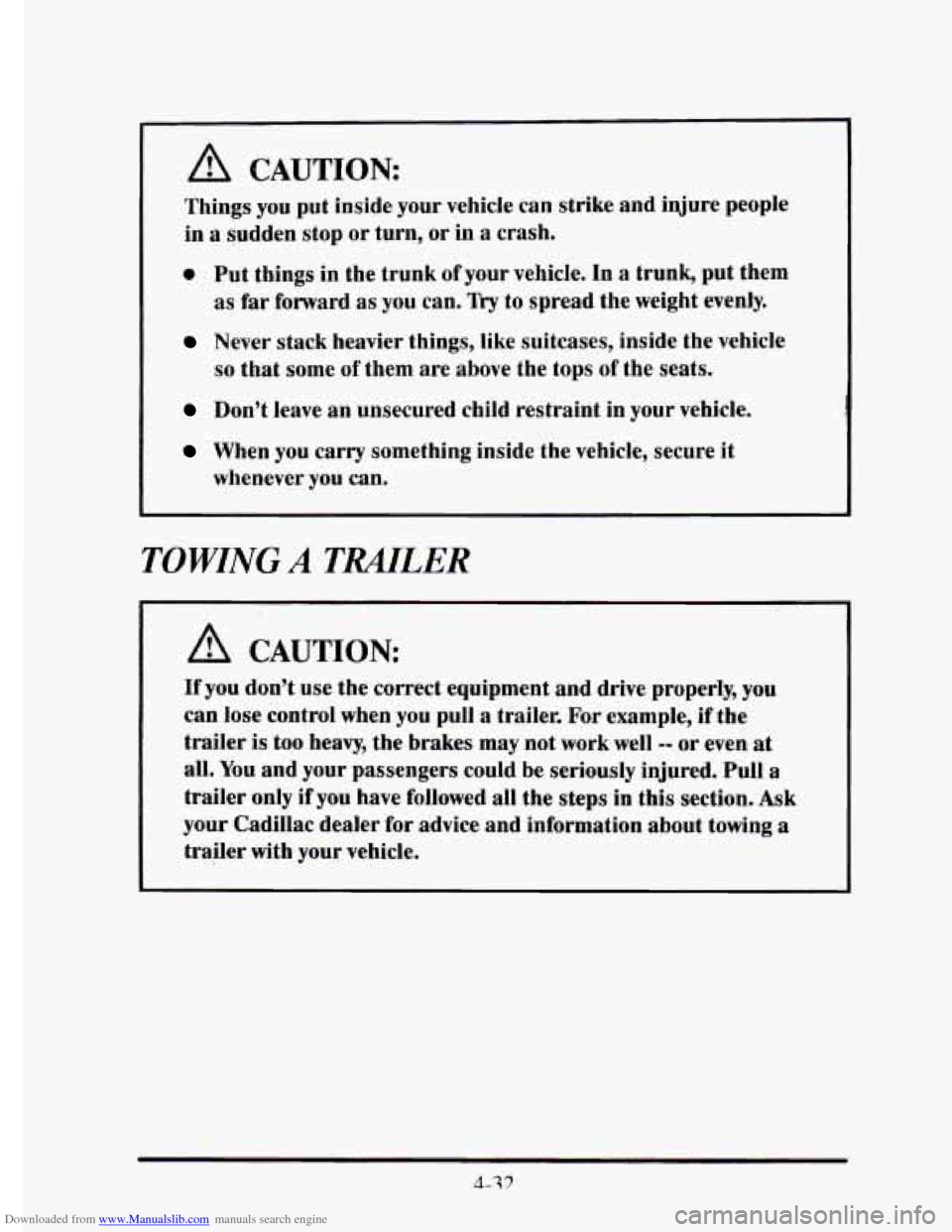
Downloaded from www.Manualslib.com manuals search engine A CAUTION
Things you put inside your vehicle can strike and injure people
in a sudden stop or turn, or in a crash.
0 Put things in the trunk of your vehicle. In a trunk, put them
as far forward as you can. ‘Ry to spread the weight evenly.
Never stack heavier things, like suitcases, inside the vehicle
so that some of them are above the tops of the seats.
Don’t leave an unsecured child restraint in your vehicle.
When you carry something inside the vehicle, secure it
whenever you can.
TOWING A TRAILER
A CAUTION:
If you don’t use the correct equipment and drive properIy, you
can lose control when you pull a trailer. For example, if the
trailer
is too heavy, the brakes may not work well -- or even at
all. You and your passengers could be seriously injured. Pull a
trailer only if you have followed all the steps in this section. Ask
your Cadillac dealer for advice and information about towing a
trailer with your vehicle.
Page 220 of 395
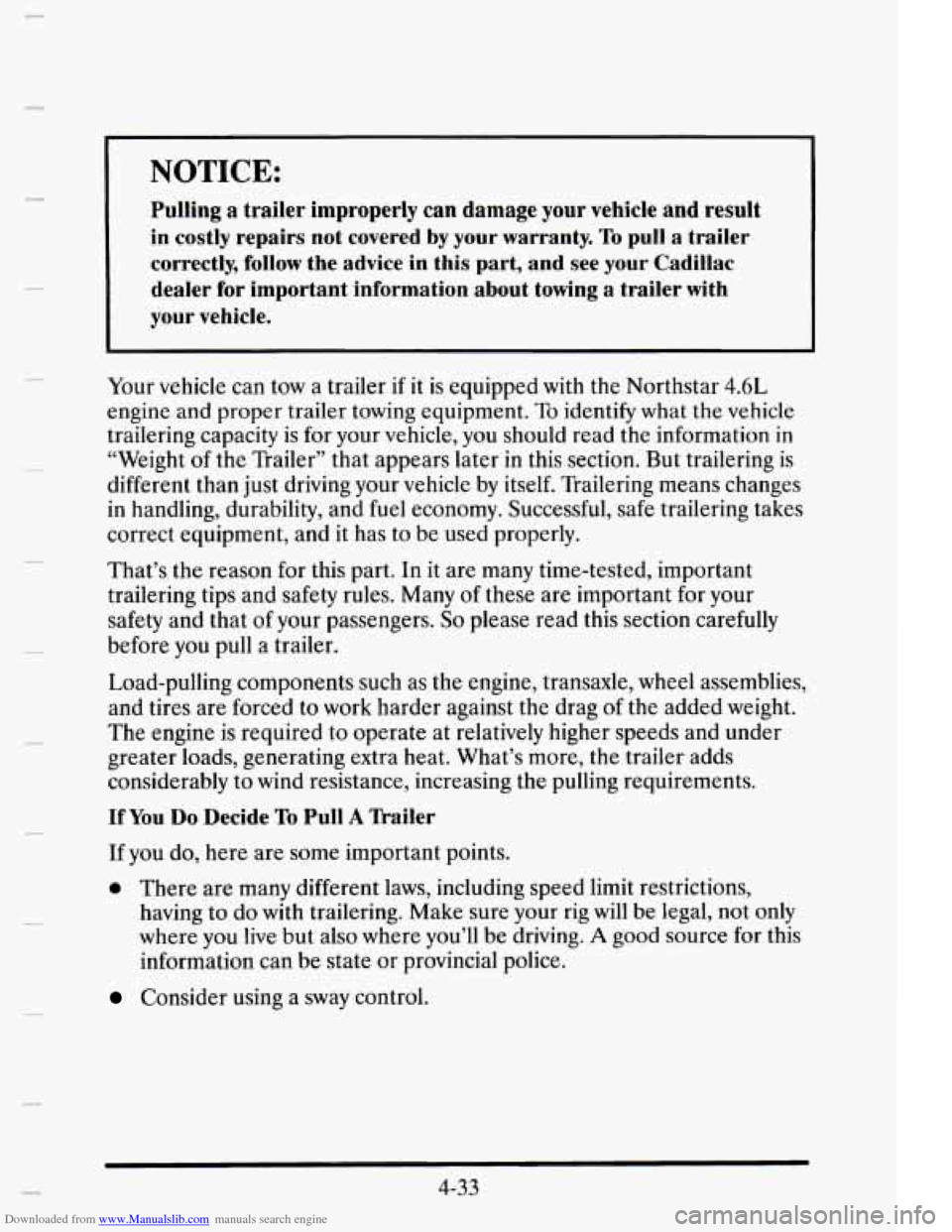
Downloaded from www.Manualslib.com manuals search engine NOTICE:
Pulling a trailer improperly can damage your vehicle and result
in costly repairs not covered by your warranty. To pull a trailer
correctly, follow the advice in this part, and see your Cadillac
dealer for important information about towing a trailer with
your vehicle.
Your vehicle can tow a trailer if it is equipped with the Northstar 4.6L
engine and proper trailer towing equipment. To identify what the vehicle
trailering capacity
is for your vehicle, you should read the information in
“Weight of the Trailer” that appears later in this section. But trailering is
different than just driving your vehicle by itself. Trailering means changes
in handling, durability, and fuel economy. Successful, safe trailering takes
correct equipment, and it has to be used properly.
That’s the reason for this part. In it are many time-tested, important
trailering tips and safety rules. Many
of these are important for your
safety and that
of your passengers. So please read this section carefully
before you pull
a trailer.
Load-pulling components such as the engine, transaxle, wheel assemblies,
and tires are forced to work harder against the drag
of the added weight.
The engine is required
to operate at relatively higher speeds and under
greater loads, generating extra heat. What’s more, the trailer adds
considerably
to wind resistance, increasing the pulling requirements.
If You Do Decide To Pull A nailer
If you do, here are some important points.
e There are many different laws, including speed limit restrictions,
having to do with trailering. Make sure your rig will
be legal, not only
where you live but
also where you’ll be driving. A good source for this
information can be state or provincial police.
Consider using a sway control.
4-33